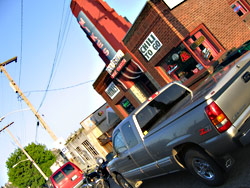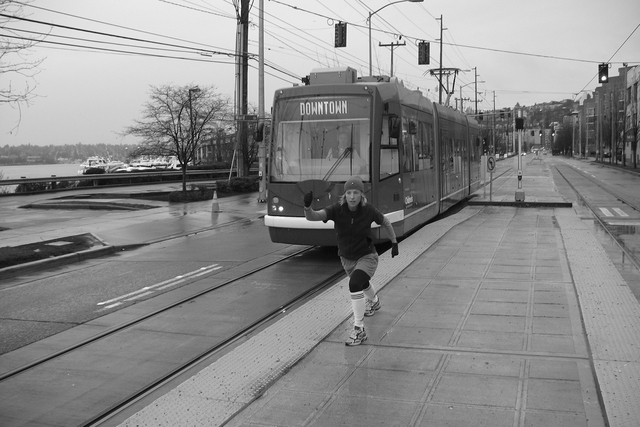There’s but one window on the southerly wall of Mike’s Tavern & Chili Parlor at the base of the Ballard Bridge. It’s back by the Golden Tee machine and a jukebox that plays Styx without irony. Out that peephole is a large, cluttered lot that’s lain vacant for five years and a little blue house owned by a famously stubborn octogenarian named Edith.
Directly beyond these properties is Salmon Bay, the industrial marine inlet just east of the Ballard Locks and Puget Sound where a Greek immigrant named Mike Semandiris began selling chili from a cart in the 1920s. The commercial fishermen, dockworkers, and ship welders lapped it up, trough by meaty trough, even after Chili Mike moved his operation a block or so inland to a low-slung brick edifice at 15th Avenue Northwest and Ballard Way. It’s been operating there since 1939.
Today, “the Chili,” as the tavern has come to be known, is operated by Semandiris’ great-grandson, also called Mike. And despite an influx of white-collar workers to the area from the likes of PATH, the Gates Foundation–funded health institute headquartered across Ballard Way from the Chili, Mike the Sequel’s regulars dress very much as they did when his great-granddad ruled the stove.
“I’ll bet I don’t get four people per week out of PATH,” says Semandiris. “We’ve built our business catering to the industrial workers who have historically been in the neighborhood.” Employers like PATH, he says, have introduced the sort of clientele who would frequent a Trader Joe’s or a health club.
Semandiris isn’t tossing out random examples: By the end of May, architect- developer Scott Clark expects to break ground on a 133,593-square-foot mixed-use development on land formerly occupied by a disposal company. The development will feature, among other entities, a Trader Joe’s supermarket, a health club, and a 468-stall parking structure that will abut Semandiris’ small building.
Dubbed “Ballard Blocks,” Clark’s development will be bordered on the east by 14th Avenue Northwest, a mile-long, freight-friendly arterial that stands to get a major face-lift if some residents get their way. Armed with a $15,000 matching grant from the city of Seattle, the 14th Avenue Northwest Visioning Project has retained Carlson Architects to draw up a master plan for the north-south boulevard that stretches from Ballard High School on Northwest 65th Street to a public boat ramp on Salmon Bay.
Work is far from done, but regular street cleanups and a vigorous neighborhood watch program have commenced. Residents are intent on keeping auto theft down and backseat bums on the move.
“I happened to notice some young guys driving around with headbands on and car alarms going off at all hours,” says 14th Avenue project steering committee member Mary Lou Olson. Residents, she says, are concerned “about crime and people camping out in their neighborhoods all the time. It’s really been a problem.”
Since the group’s first cleanup in November, visions of grassy, tree-lined medians and ultrawide sidewalks have been trumpeted, synching nicely with the yuppie-topia Clark has planned for the area surrounding Mike’s Chili Parlor, which includes Northwest 46th Street.
But there’s a catch: Forty-sixth and 14th are two of maybe a half-dozen key corridors that connect Ballard’s sizable industrial area with the rest of the world. Area watchdogs fear that Ballard Blocks and, to a lesser extent, the 14th Avenue project could be at odds with standards adopted by the Ballard Interbay Northend Manufacturing and Industrial Center (BINMIC), one of only two industry-preservation areas (the other being along the Duwamish River) designated in the city’s 1994 Comprehensive Plan.
“If you put a bunch of destination retail traffic on a major truck street, it just keeps compromising the industrial sector,” says emeritus BINMIC Chair Warren Aakervik, owner-operator of Ballard Oil. “We keep taking commercial areas and making them more residential, so commercial moves to land zoned industrial. It’s an erosion of the base of industry, and once you’ve eroded it to where it doesn’t exist, where’s your GNP going to come from?” Says Dave Gering, head of the Manufacturing and Industrial Council of Greater Seattle: “You put the Duwamish and BINMIC together, and there’s more employment in the Seattle city limits than any other industrial center in the state. This is a really industrial city. It just can’t see that about itself.”
Hop on a trawler and cruise the canal, Gering argues, and perceptions change. “Ballard is definitely changing—nobody can stop that,” he acknowledges. “But when you go out on the water, you appreciate the fact that you’re surrounded by the largest fishing fleet in the Pacific Northwest. These companies are all here because of those boats. They need welders, they need architects—they’re constantly being worked on.
“You’ve got marine infrastructure down there that cannot be replicated elsewhere,” Gering says. “That’s what’s at jeopardy here. The city really needs to stand by the zoning down there. That community serves an economic function that Trader Joe’s never will, which is transporting exports to other countries. That’s what makes this country rich—not retail.”
Neither do vacant lots, says longtime city employee Rob Mattson, pointing out that the Ballard Blocks property has gone unused and abused for the better part of the past decade.
“It’s been a dumping ground for boats and cars,” says Mattson, who runs the Ballard Neighborhood Center. “We had a 52-foot fishing boat dumped there—and it sat until it burned. It’s also historically been a home to area transients. I think everyone’s going to be very happy when Scott’s project is done.”
Not Semandiris, who, on March 29, filed a land use petition in King County Superior Court to have Clark’s project halted and re-evaluated. A hearing is scheduled for June 2. This action comes on the heels of two failed appeals to the city Hearing Examiner’s Office. Semandiris alleges manifold flaws in Clark’s transportation impact analysis conducted by Heffron Transportation. Chief among these shortcomings, says Semandiris, is Heffron’s claim that “on-street parking immediately adjacent to the sites is used by few vehicles.” A recent weekday-morning drive through the neighborhood found virtually all on-street parking spaces occupied. This is nothing compared to Wednesday nights, says Semandiris, when the burgeoning Christian megachurch Mars Hill, which opened a 40,000-square-foot complex in 2003 to the immediate east of PATH, holds midweek services.
“When church is going on and it’s really packed, my customers just keep driving,” says Semandiris. “The neighborhood is so overstressed and overloaded already that trying to put a max development in here is not a friendly idea. And just because there’s a parking structure doesn’t mean that people won’t park in the street.
“That property needs to be developed,” adds Semandiris, alluding to Clark’s land, which was purchased for $6 million, “but does it need to fit, or does it need to be maxed out?”
“Mike tried to have the appeal appealed, and it was upheld again,” counters Clark, who lived and worked in Ballard for 12 years before moving to Lower Queen Anne. “Frankly, he doesn’t have any justification. I know this community and what all the hot buttons are, and we’ve been very, very careful.”
The 14th Avenue project’s Olson strikes a similarly measured tone. “We would like 14th to be a safe, quiet street,” she says. “But it has to be functional for the people south of Market Street. We’re not cage-rattlers—we’re looking out for everyone.”
It might be too late for BINMIC forces to do anything but throw up their hands. A growing Mars Hill congregation, for example, recently purchased two dormant industrial buildings, on Northwest 50th Street and 14th Avenue Northwest, for $3.2 million.
“We’re going to become a bedroom community,” laments longtime Ballard real-estate agent Barry Hawley, who brokered the Ballard Blocks deal. “Everything is so out of balance, and only now do we realize it.” Adds Mattson, the city employee: “Costs are being driven artificially high by commercial developments. When land’s going for $60 to $90 per square foot, industry’s not going to be able to touch it.”









